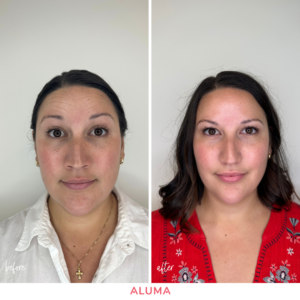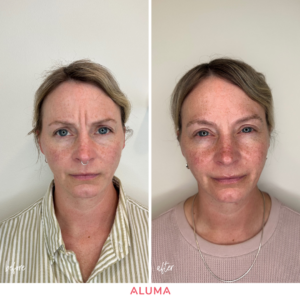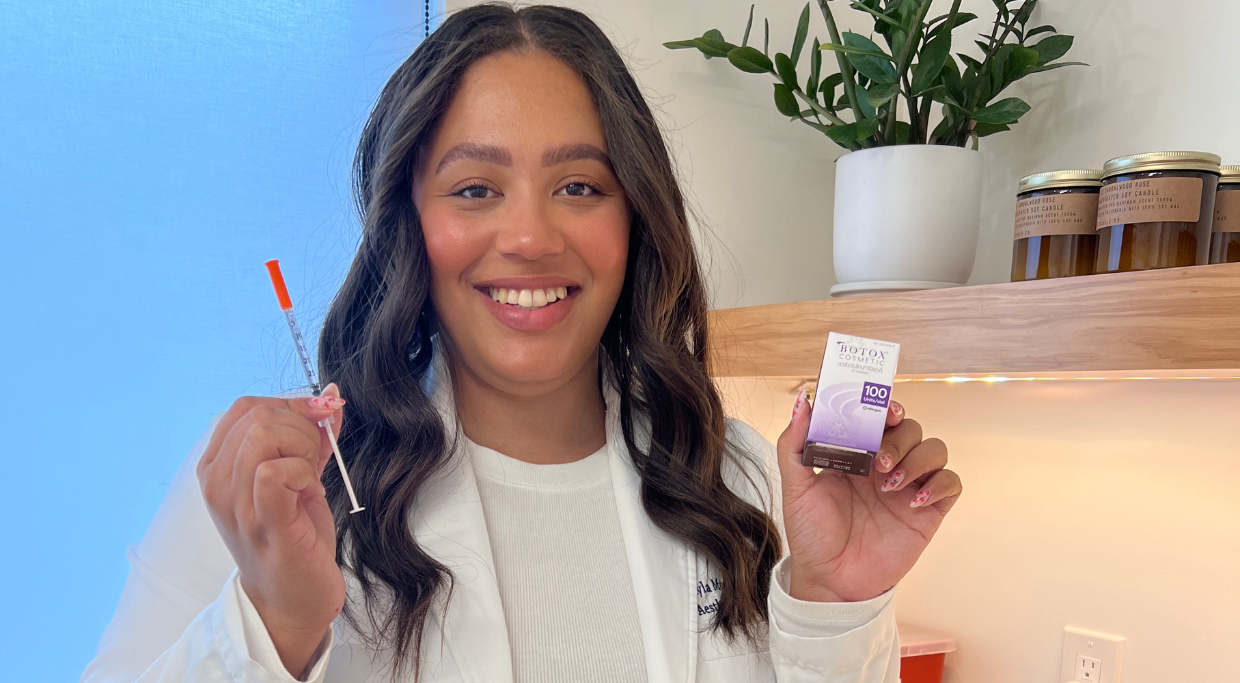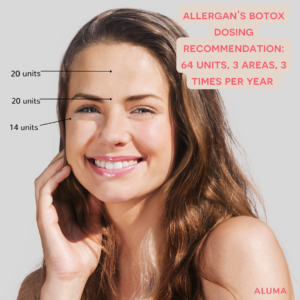At Aluma Aesthetic Medicine in Portland, OR, one of the most frequently asked questions is, “How long does Botox last?” The answer isn’t as straightforward as you might think. The longevity of Botox results depends on various factors, including the treatment area, dosage, frequency of treatments, and individual patient goals. However, on average, Botox lasts about three months, with variations based on personal treatment choices.
Let’s dive into the details to help you understand how long Botox lasts, what influences the duration, and how your treatment plan can be tailored for optimal results.
The Science Behind Botox Duration
Allergan, the manufacturer of Botox, recommends a standard dosage of 64 units to treat the entire face, specifically targeting the three FDA-approved areas: forehead lines, frown lines between the eyes (glabella), and crow’s feet (lateral canthal lines). This treatment is advised three times per year, with an average interval of four months between sessions. As a general rule, Botox results typically last around three to four months, with higher doses extending the effects to the four-month marker. Lighter doses result in a shorter duration, closer to two and a half months.
Breaking Down the FDA-Approved Treatment Areas by Dose: Our Take
When injecting Botox, it’s essential to recognize how different facial areas respond to different doses, depending on muscle size, action, and structure. Here are our recommendations on Botox dosage for the three most treated areas at Aluma:
1. Forehead (Frontalis)
- Botox Duration: About 2.5–3 months
- The frontalis muscle, responsible for lifting the eyebrows, is often treated to smooth out horizontal forehead lines. A higher dose in this area can extend the results but may cause a heavy feeling or even headaches in some patients. At Aluma, we typically recommend a lighter dose of 10-15 units to avoid these issues. This dose provides comfortable results but may lead to subtle expression lines resurfacing after about 2.5 months.
2. Frown/Angry Lines (Glabella)
- Botox Duration: 3-4 months
- The glabella, or the “11’s” between the eyebrows, is a strong muscle that pulls the brows inward and down. For best results, we recommend a dose of 15-20 units. The results brighten the eyes as the glabella muscle no longer pulls them down. You can also count on a softening of the lines between the brows, with results that often last three to four months.
3. Crow’s Feet (Lateral Canthal Lines)
- Botox Duration: 2.5–3 months
- Crow’s feet form from the orbicularis oculi muscle, which surrounds the eye and creates a genuine smile with lines forming during expression. A lighter dose here, 5-10 units, ensures that while fine lines around the eyes are reduced, you avoid the side effect of under-eye bagginess accompanying too large of a dose in this area. However, like the forehead, slight lines may reappear after about 2.5 months.
Botox Before and After Photos


Tailoring Botox to Your Preferences
Every patient has different goals when it comes to Botox. Some prefer a more “immobile” look with little to no expression lines, which requires a higher dose and offers a longer duration. Others prefer softer, more natural results and are comfortable with soft expression lines after a couple of months. A lower dose is appropriate for these patients.
Dose and Duration: Striking the Right Balance
- Higher Dose: Extends the duration to 3.5 – 4 months plus.
- Lower Dose: Results in a shorter duration of about 2.5 months.
Is Botox Safe
Botulinum toxin has an impressive safety record when used for both medical and cosmetic purposes. A 2004 systematic review of randomized trials involving 1,425 patients found no reports of serious adverse effects from onabotulinumtoxinA. Similarly, the FDA reported only 36 serious adverse effects related to cosmetic use between 1989 and 2003. Most side effects were mild, like injection site reactions and headaches, though a few cases involved more severe symptoms, such as muscle weakness and allergic reactions. Many of these serious side effects occurred in patients with pre-existing medical conditions.
In addition, repetitive Botox treatments are safe over time. A study of over 4,000 treatments in 945 patients found that most side effects, such as bruising and drooping eyelids, were mild and decreased with repeated injections. Another interesting aspect of long-term Botox use is the possibility of needing fewer treatments over time. Studies suggest that patients may need it less frequently after regular Botox treatments for a few years. This is likely due to the weakening of targeted muscles, reducing their ability to pull on the skin and form wrinkles.
Can a “Mini” Botox Treatment Work?
At Aluma, we sometimes encounter clients who want to “trial” Botox with a very light dose. While understandable, we generally do not recommend this approach. Lighter doses result in shorter-lasting results and sometimes suboptimal wrinkle relaxation. In addition, over time, due to the decrease in duration, patients tend to get treated more frequently than three times per year. Some studies suggest this may lead to the development of a tolerance to Botox (botulinum toxin A), meaning that future treatments might become less effective.
In Conclusion
The longevity of Botox depends on several factors, such as treatment area, dosage, and individual preferences. While Botox typically lasts around three months, personalized dosing and treatment plans can extend or shorten results. Patients who receive Botox regularly may need fewer treatments over time. At Aluma Aesthetic Medicine in Portland, Oregon, our board-certified practitioners work with you to tailor your Botox treatment to your specific goals, whether you want to maximize the duration of your results or prefer a more natural, flexible look. Book your Botox treatment today to achieve the perfect balance between longevity and optimal results!
Citations:
Carruthers, J. (2022). Overview of botulinum toxin for cosmetic indications. In J. S. Dover & A. O. Ofori (Eds.), UpToDate.
Kane, M., Donofrio, L., Ascher, B., et al. (2010). Expanding the use of neurotoxins in facial aesthetics: A consensus panel’s assessment and recommendations. Journal of Drugs in Dermatology, 9(s7).
Cliff, S. H., Judodihardjo, H., & Eltringham, E. (2008). Different formulations of botulinum toxin type A have different migration characteristics: A double-blind, randomized study. Journal of Cosmetic Dermatology, 7, 50.
Naumann, M., & Jankovic, J. (2004). Safety of botulinum toxin type A: A systematic review and meta-analysis. Current Medical Research and Opinion, 20(7), 981.










